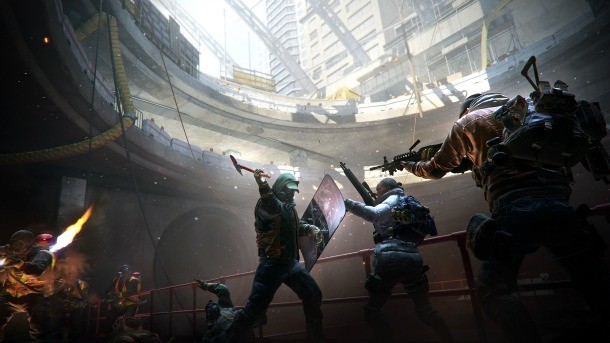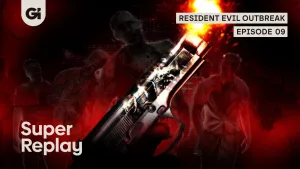Subscribe today to get the first appearance of Dragon Quest on our cover!
Eight Tips From The Division Devs To Help You Get Some Sweet Loot

Yesterday, I ventured into New York City (the real one, not the plague-ridden version in The Division) to catch up with two members of The Division team. Producer Tony Sturtzel and game director Terry Spier from Red Storm shared some tips to get the most out of your early hours.
We also pried out a secret waiting for intrepid agents. They wouldn’t get too specific, but the hints have us excited for what might be waiting on the streets of New York.

Get Hard!
You can play The Division alone, taking on missions to restore New York City to its former glory. However, Ubisoft Massive and its cohort studios (Red Storm, Reflections, and Annecy) built The Division for cooperative play.
You can get a leg up early on by rounding up your team and pushing yourself to the limits. “Maybe I’m kind of a sucker for pain, but I recommend doing as many hard missions as possible first, even if you’re under-geared,” Spier says. “The kind of gear you get from hard missions is going to push you over the curve. You’ll get better faster if you do a main mission and then do it on hard right away.”

You’ve Got a Friend in Me
Even if you don’t have friends online, keep an eye on what other agents are doing. Stepping in to help someone in trouble might end up benefitting you in the long-run.
“Find some friends to group up with,” Sturtzel says. “One of the best ways to do that is to help people out, especially in the Dark Zone. If you help someone finish their extraction (and you don’t shoot them), chances are you can partner up to get through some of the harder areas. That inevitably is going to lead to better gear. It’s all about leveling. We’re an RPG.”

Be a Specialist, Not a Jack-of-all-Trades
You’ll notice early on that you have three main branches to put stat points into. You'll be shunted into the Medical branch early on, with Tech and Security missions requiring a higher level to complete.
You can re-spec at any time, so there’s no harm in driving right down the Medical lane. But once you have access to more skills, you’ll still be better positioned if you hone in and specialize. Don't worry, you can change things up on the fly later if you don't like your selections.
The same goes for your gear. You want to equip yourself with gear that boosts one of the three main stats: health, firearms (damage), and electronics (skill power).
“Pick a stat,” Spier says. “Everyone has their own play style, but find the gear with the stat that you want to focus on. If you want to crunch out the DPS, or high health, or your skills to really kill people, don’t just generalize. Find the gear that has the stats you want.”
The emphasis on these stats might mean choosing a weapon with lower damage output that focuses on your key attribute. We don’t know the extent of the min-maxing players can do, but these top-level choices matter.
Part of those decisions come in the form of weapon mods. We saw a bit of it in the beta, but there’s more to explore.
“They help you drill down a lot more into your specific play style,” Sturtzel says. “So you may be maximizing your skill power, but a mod may have a talent on it.” Putting together a build that takes into account gear, weapons, and mod talents and attributes will allow you to tune to maximize your specific approach.

Follow the Boy Scout Motto
Because you can re-spec your skills at any point, The Division offers flexibility. From one play session to the next, you can be a tank, a healer, or dish out DPS. However, you might be missing one important piece of the puzzle: gear.
It’s all well and good to change up your skills, but if you don’t have the weapons, mods, and gear in support, you’re not going to be as effective.
“Assuming you’ve prepared for this moment, and you have the gear for health and you’ve got the healing skills (assuming you’ve unlocked them through the campaign), it’s fast,” Spier says. You can re-mod a gun on the fly, and mods aren’t consumed if removed from a weapon. You just want to make sure you’re prepared and carrying the right gear with you to fully make the change.

Playing Casually? Don’t Go to the Dark Zone
In addition to the strictly cooperative aspects, there is a player-vs-player-vs-A.I. area called the Dark Zone. There, you’ll be able to find great loot, but also run the risk of losing it to other players that have turned rogue. Red Storm suggests that you keep your wits about you when entering this difficult area. If you want to play more casually, stick to the PvE zones.
“You can’t mess around in the Dark Zone,” Spier says. “If you just want to laze around, don’t go to the Dark Zone, because you’ll lose. It’s difficult from an A.I. perspective. You have to be on.”
In the Dark Zone, you can turn rogue by attacking other players. The benefit is that you can bypass much of the work tied to getting the best loot. The trick is that going rogue marks you for a limited amount of time that grows as you kill more agents.
A bounty will be placed on your head and you'll be hunted. But if you manage to hide and let the timer wind down, you'll get to keep your loot, and the bounty will be yours. Get killed, and your Dark Zone rank goes down, you lose the loot, and someone else will get rich from taking you out.
“The Dark Zone is all about greed,” Spier says. “You want to take a shortcut. The people who have the pretty, little, yellow sack on their back, they’ve done things. They’ve killed AI and looted some chests. You can take that from them. The reward you get from surviving is the rush. How far can you go knowing the entire Dark Zone is after you?”
In order to survive your rogue status, you need to wait for a timer to wind down. Should you manage to outlast the clock, you’ll get the gear, the bounty, a rank boost, and the satisfaction of knowing you’ve outsmarted other agents. But before that timer runs out, you’re marked, and you can’t leave the Dark Zone.
Now You See Me…
This one isn’t going to apply to everyone, but if you happen to have an eye-tracker, you might want to turn it on for The Division. Both the Tobii EyeX and SteelSeries Sentry support a number of gaze-based features. You can use the eye-tracking software to mark enemies for your friends, aim grenades, identify additional cover, and even scale back the user interface so that individual elements are triggered only when you look at that area of the screen.
“Given some time with that system, it’s going to be crazy,” Spier said. “It’s definitely a positive.”

Keep Your Eyes Peeled for Easter Eggs
While Spier and Sturtzel were largely quiet about specific hidden items, we did get a few hints. First, we were encouraged to visit well-known landmarks. “If you know a landmark, go there,” Spier says. “You’ll probably find something.” He wouldn’t say just what form that would take, though.
The pair suggest that the Dark Zone is where the best loot can be found, and it also holds some of the game's secrets. Specifically, we were encouraged to explore the subways. “The subways in the Dark Zone? That’s a great place to go to,” Sturtzel says.
“Also, Rockefeller,” Spier suggests. “It’s ridiculous.”
In the real Rockefeller Center, there’s an underground concourse where you can find a subway station. The Division’s subway also connects to the shopping area that exists there in the real New York. “The kind of depth we were able to create there, and the difficulty… it could be one of the most rewarding spots in the game,” Sturtzel says. “It’s not easy.”
Familiar Faces
While we couldn’t get specifics, we were told that there are nods to other Ubisoft games hidden within The Division. If you happen to get a loot drop that looks familiar, let us know. We’re curious what might be lurking in the darkened corners of New York City.

Get the Game Informer Print Edition!
Explore your favorite games in premium print format, delivered to your door.
- 10 issues per year
- Only $4.80 per issue
- Full digital magazine archive access
- Since 1991









